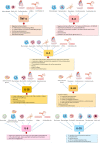Inflammation in Human Heart Failure: Major Mediators and Therapeutic Targets
- PMID: 34707513
- PMCID: PMC8543018
- DOI: 10.3389/fphys.2021.746494
Inflammation in Human Heart Failure: Major Mediators and Therapeutic Targets
Abstract
Inflammation has been recognized as a major pathophysiological contributor to the entire spectrum of human heart failure (HF), including HF with reduced ejection fraction, HF with preserved ejection fraction, acute HF and cardiogenic shock. Nevertheless, the results of several trials attempting anti-inflammatory strategies in HF patients have not been consistent or motivating and the clinical implementation of anti-inflammatory treatments for HF still requires larger and longer trials, as well as novel and/or more specific drugs. The present work reviews the different inflammatory mechanisms contributing to each type of HF, the major inflammatory mediators involved, namely tumor necrosis factor alpha, the interleukins 1, 6, 8, 10, 18, and 33, C-reactive protein and the enzymes myeloperoxidase and inducible nitric oxide synthase, and their effects on heart function. Furthermore, several trials targeting these mediators or involving other anti-inflammatory treatments in human HF are also described and analyzed. Future therapeutic advances will likely involve tailored anti-inflammatory treatments according to the patient's inflammatory profile, as well as the development of resolution pharmacology aimed at stimulating resolution of inflammation pathways in HF.
Keywords: acute heart failure (AHF); anti-inflammatory strategies; cardiogenic shock (CS); chronic heart failure (CHF); clinical trials; inflammation; inflammatory mediators.
Copyright © 2021 Reina-Couto, Pereira-Terra, Quelhas-Santos, Silva-Pereira, Albino-Teixeira and Sousa.
Conflict of interest statement
The authors declare that the research was conducted in the absence of any commercial or financial relationships that could be construed as a potential conflict of interest.
Figures


References
-
- Abbate A., Van Tassell B. W., Biondi-Zoccai G., Kontos M. C., Grizzard J. D., Spillman D. W., et al. (2013). Effects of interleukin-1 blockade with anakinra on adverse cardiac remodeling and heart failure after acute myocardial infarction [from the Virginia Commonwealth University-Anakinra Remodeling Trial (2) (VCU-ART2) pilot study]. Am. J. Cardiol. 111 1394–1400. 10.1016/j.amjcard.2013.01.287 - DOI - PMC - PubMed
-
- Adamson P. B., Abraham W. T., Bourge R. C., Costanzo M. R., Hasan A., Yadav C., et al. (2014). Wireless pulmonary artery pressure monitoring guides management to reduce decompensation in heart failure with preserved ejection fraction. Circ. Heart Fail. 7 935–944. 10.1161/CIRCHEARTFAILURE.113.001229 - DOI - PubMed
Publication types
LinkOut - more resources
Full Text Sources
Research Materials
Miscellaneous

